Geotechnics Report: Geological Hazards in Gateshead Quays Area
VerifiedAdded on 2022/09/18
|8
|1025
|20
Report
AI Summary
This report, prepared for a civil engineering course at Teesside University, examines the geological hazards present in the Gateshead Quays area. It begins with an introduction to the location and context, followed by a detailed description of the geological setting, including bedrock lithology and superficial deposits. The report then categorizes and analyzes both natural and human-induced hazards that pose risks to construction and infrastructure in the area. Human-induced hazards discussed include those related to mining and construction activities, while natural hazards cover geophysical, climatological, and meteorological events. Mitigation measures, such as building codes, zoning practices, and reinforcement strategies, are proposed to minimize potential damage. The report concludes by emphasizing the importance of proactive measures to ensure safe and sustainable construction practices despite the inherent geological risks. The provided references support the analysis and findings presented in the report.
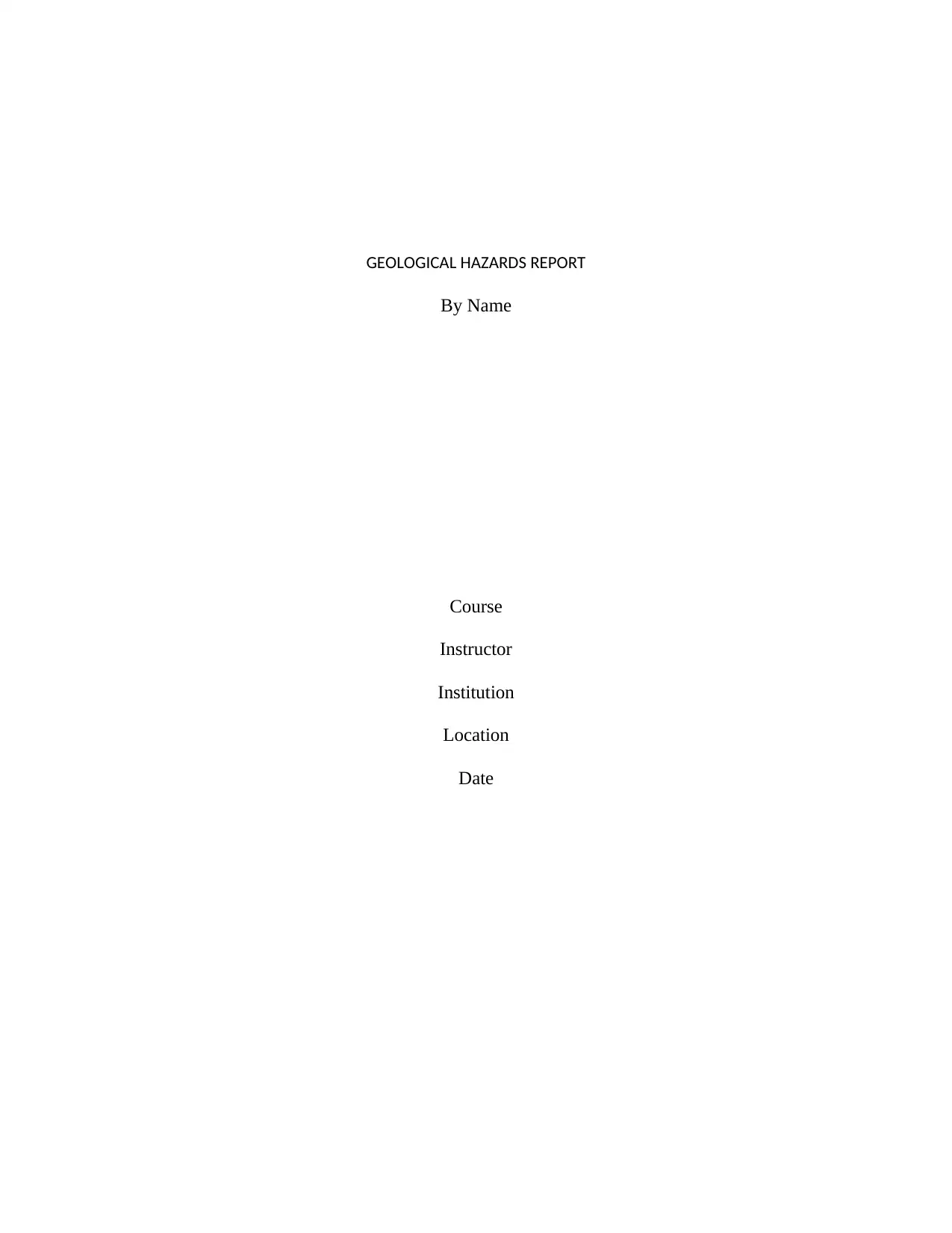
GEOLOGICAL HAZARDS REPORT
By Name
Course
Instructor
Institution
Location
Date
By Name
Course
Instructor
Institution
Location
Date
Paraphrase This Document
Need a fresh take? Get an instant paraphrase of this document with our AI Paraphraser
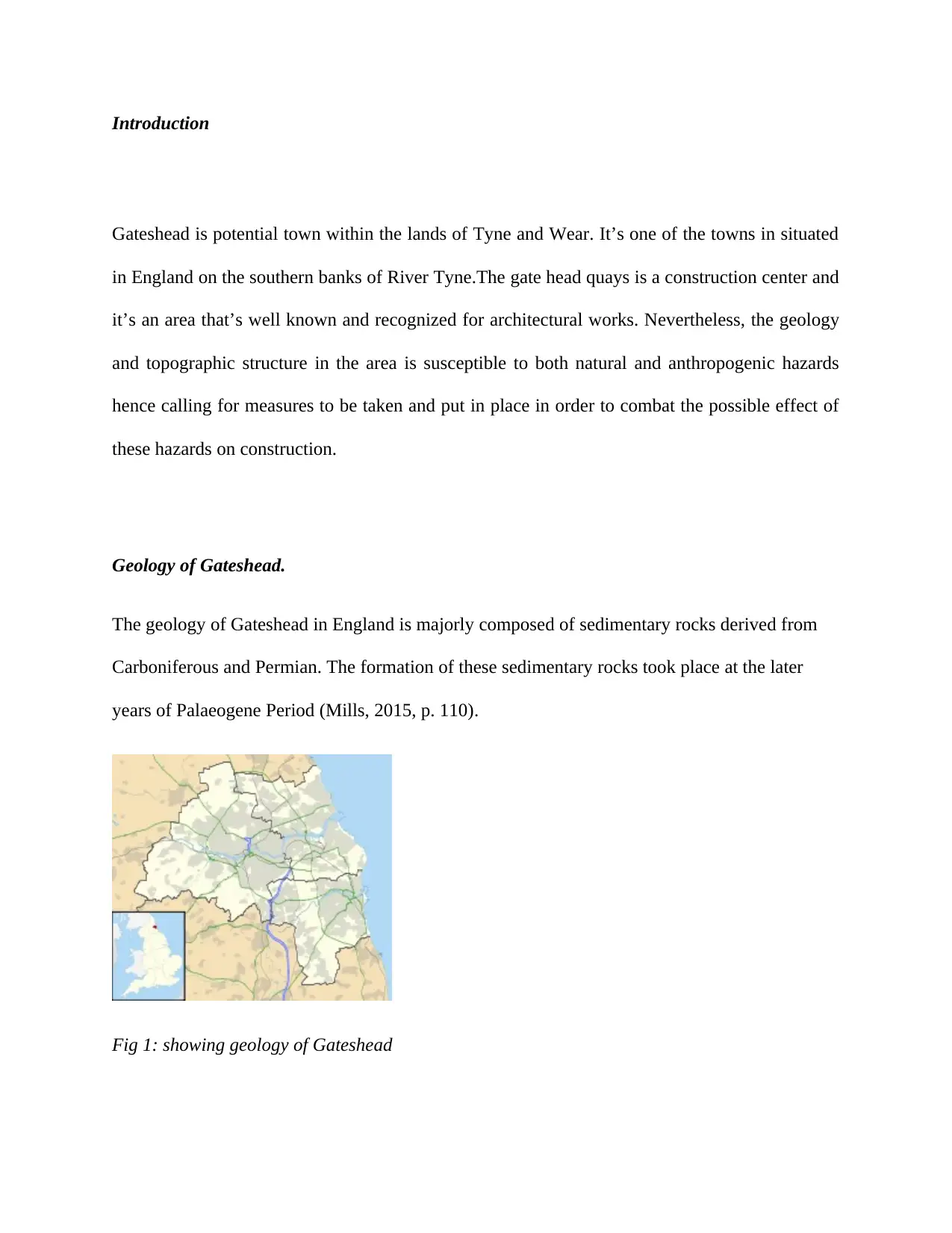
Introduction
Gateshead is potential town within the lands of Tyne and Wear. It’s one of the towns in situated
in England on the southern banks of River Tyne.The gate head quays is a construction center and
it’s an area that’s well known and recognized for architectural works. Nevertheless, the geology
and topographic structure in the area is susceptible to both natural and anthropogenic hazards
hence calling for measures to be taken and put in place in order to combat the possible effect of
these hazards on construction.
Geology of Gateshead.
The geology of Gateshead in England is majorly composed of sedimentary rocks derived from
Carboniferous and Permian. The formation of these sedimentary rocks took place at the later
years of Palaeogene Period (Mills, 2015, p. 110).
Fig 1: showing geology of Gateshead
Gateshead is potential town within the lands of Tyne and Wear. It’s one of the towns in situated
in England on the southern banks of River Tyne.The gate head quays is a construction center and
it’s an area that’s well known and recognized for architectural works. Nevertheless, the geology
and topographic structure in the area is susceptible to both natural and anthropogenic hazards
hence calling for measures to be taken and put in place in order to combat the possible effect of
these hazards on construction.
Geology of Gateshead.
The geology of Gateshead in England is majorly composed of sedimentary rocks derived from
Carboniferous and Permian. The formation of these sedimentary rocks took place at the later
years of Palaeogene Period (Mills, 2015, p. 110).
Fig 1: showing geology of Gateshead
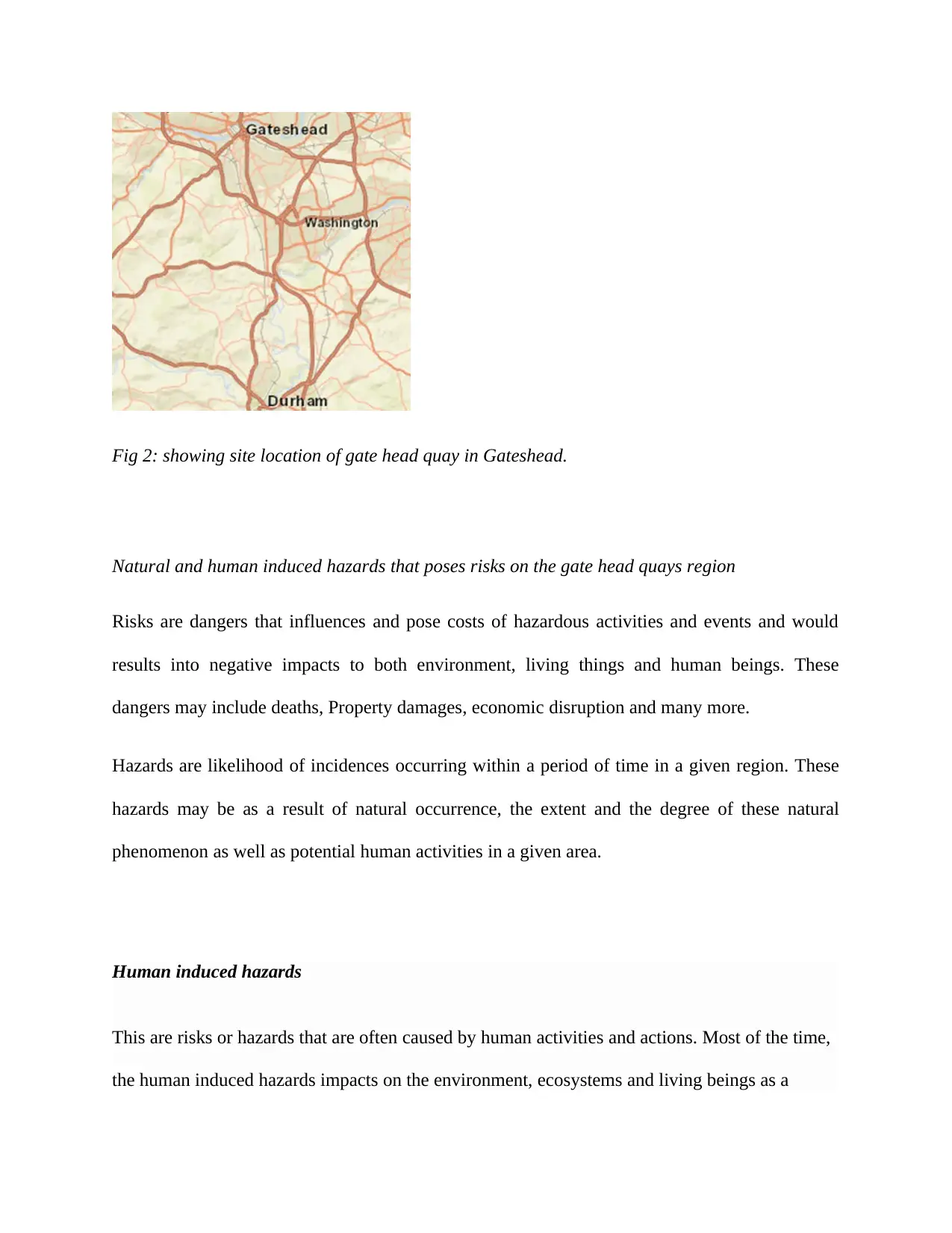
Fig 2: showing site location of gate head quay in Gateshead.
Natural and human induced hazards that poses risks on the gate head quays region
Risks are dangers that influences and pose costs of hazardous activities and events and would
results into negative impacts to both environment, living things and human beings. These
dangers may include deaths, Property damages, economic disruption and many more.
Hazards are likelihood of incidences occurring within a period of time in a given region. These
hazards may be as a result of natural occurrence, the extent and the degree of these natural
phenomenon as well as potential human activities in a given area.
Human induced hazards
This are risks or hazards that are often caused by human activities and actions. Most of the time,
the human induced hazards impacts on the environment, ecosystems and living beings as a
Natural and human induced hazards that poses risks on the gate head quays region
Risks are dangers that influences and pose costs of hazardous activities and events and would
results into negative impacts to both environment, living things and human beings. These
dangers may include deaths, Property damages, economic disruption and many more.
Hazards are likelihood of incidences occurring within a period of time in a given region. These
hazards may be as a result of natural occurrence, the extent and the degree of these natural
phenomenon as well as potential human activities in a given area.
Human induced hazards
This are risks or hazards that are often caused by human activities and actions. Most of the time,
the human induced hazards impacts on the environment, ecosystems and living beings as a
⊘ This is a preview!⊘
Do you want full access?
Subscribe today to unlock all pages.

Trusted by 1+ million students worldwide
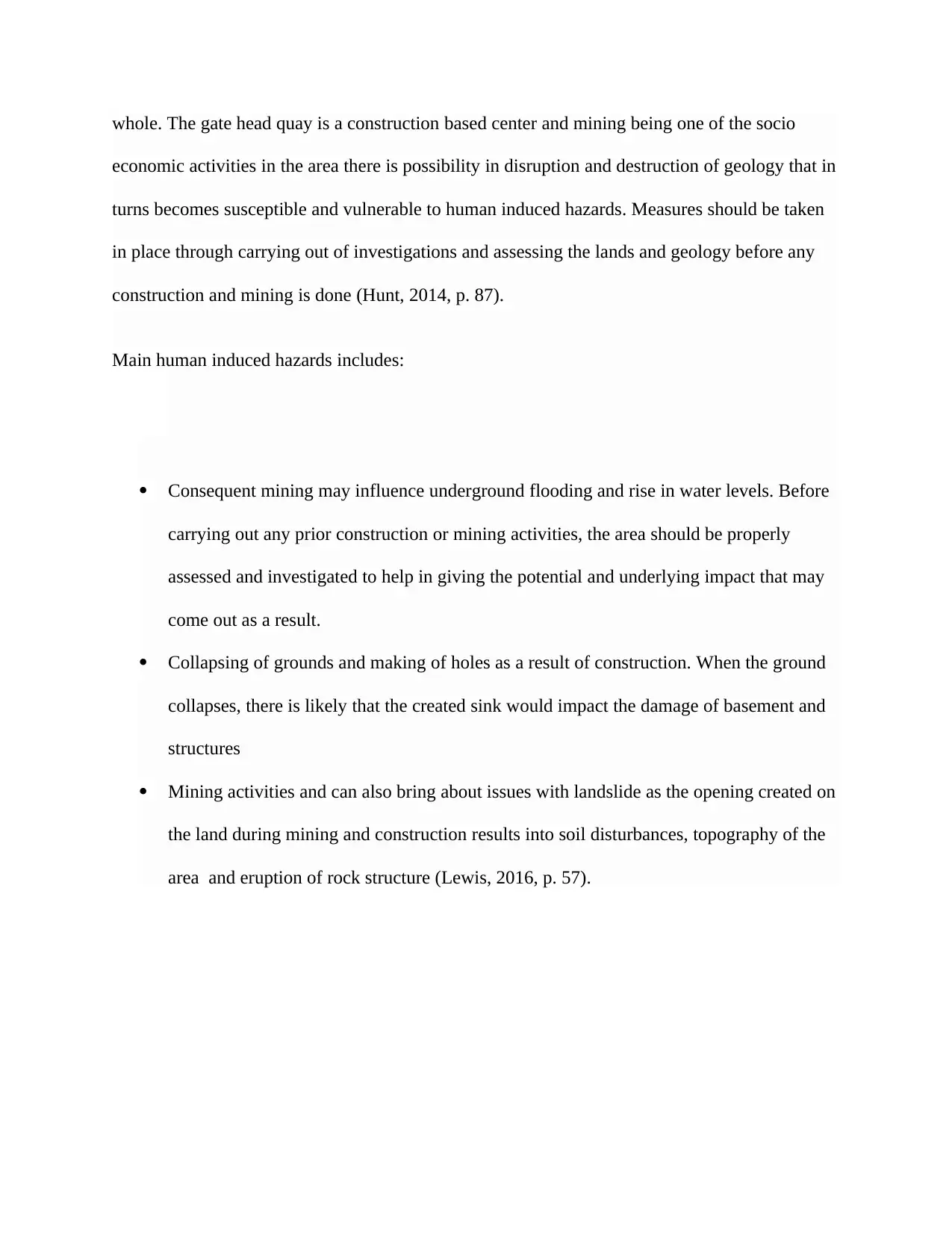
whole. The gate head quay is a construction based center and mining being one of the socio
economic activities in the area there is possibility in disruption and destruction of geology that in
turns becomes susceptible and vulnerable to human induced hazards. Measures should be taken
in place through carrying out of investigations and assessing the lands and geology before any
construction and mining is done (Hunt, 2014, p. 87).
Main human induced hazards includes:
Consequent mining may influence underground flooding and rise in water levels. Before
carrying out any prior construction or mining activities, the area should be properly
assessed and investigated to help in giving the potential and underlying impact that may
come out as a result.
Collapsing of grounds and making of holes as a result of construction. When the ground
collapses, there is likely that the created sink would impact the damage of basement and
structures
Mining activities and can also bring about issues with landslide as the opening created on
the land during mining and construction results into soil disturbances, topography of the
area and eruption of rock structure (Lewis, 2016, p. 57).
economic activities in the area there is possibility in disruption and destruction of geology that in
turns becomes susceptible and vulnerable to human induced hazards. Measures should be taken
in place through carrying out of investigations and assessing the lands and geology before any
construction and mining is done (Hunt, 2014, p. 87).
Main human induced hazards includes:
Consequent mining may influence underground flooding and rise in water levels. Before
carrying out any prior construction or mining activities, the area should be properly
assessed and investigated to help in giving the potential and underlying impact that may
come out as a result.
Collapsing of grounds and making of holes as a result of construction. When the ground
collapses, there is likely that the created sink would impact the damage of basement and
structures
Mining activities and can also bring about issues with landslide as the opening created on
the land during mining and construction results into soil disturbances, topography of the
area and eruption of rock structure (Lewis, 2016, p. 57).
Paraphrase This Document
Need a fresh take? Get an instant paraphrase of this document with our AI Paraphraser
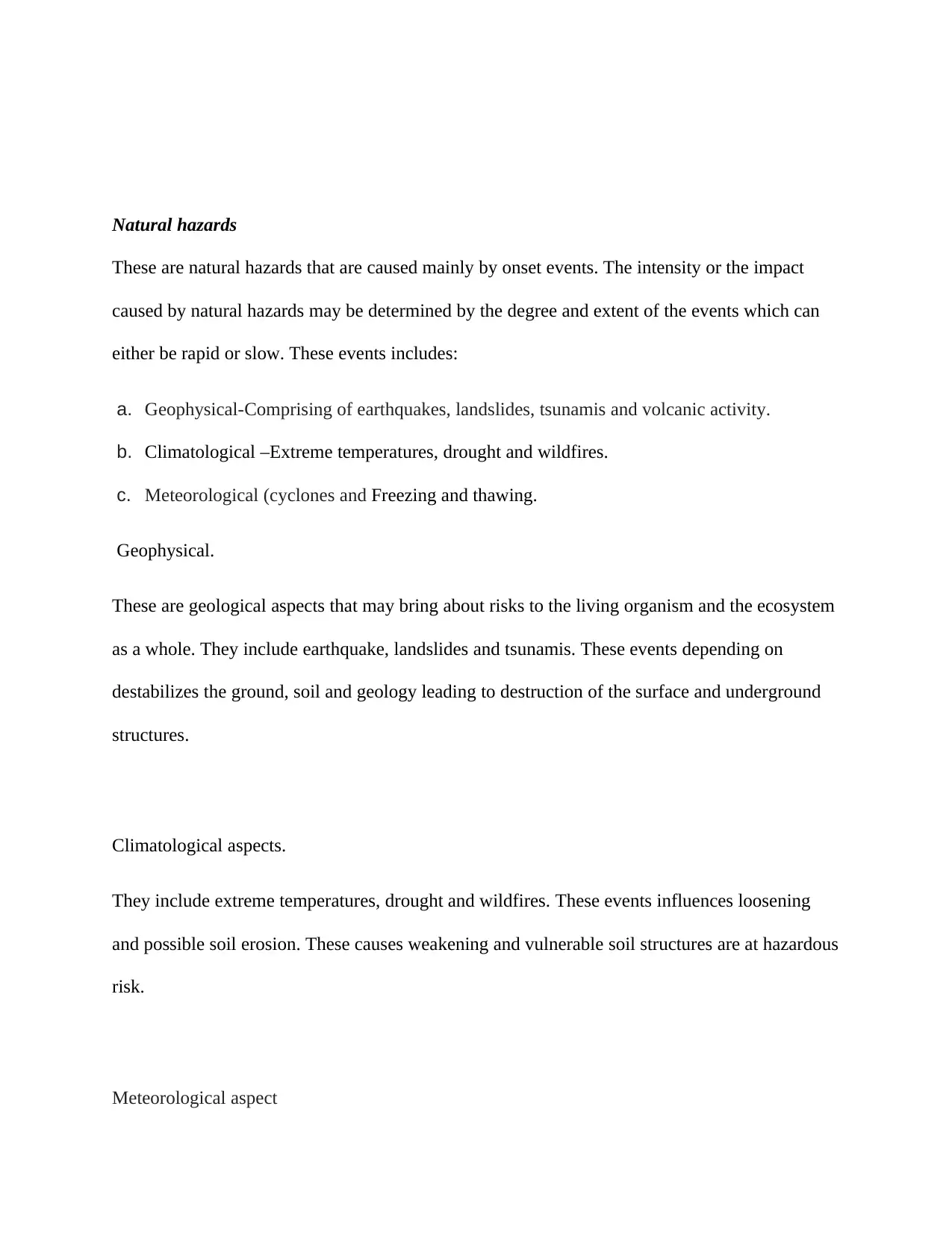
Natural hazards
These are natural hazards that are caused mainly by onset events. The intensity or the impact
caused by natural hazards may be determined by the degree and extent of the events which can
either be rapid or slow. These events includes:
a. Geophysical-Comprising of earthquakes, landslides, tsunamis and volcanic activity.
b. Climatological –Extreme temperatures, drought and wildfires.
c. Meteorological (cyclones and Freezing and thawing.
Geophysical.
These are geological aspects that may bring about risks to the living organism and the ecosystem
as a whole. They include earthquake, landslides and tsunamis. These events depending on
destabilizes the ground, soil and geology leading to destruction of the surface and underground
structures.
Climatological aspects.
They include extreme temperatures, drought and wildfires. These events influences loosening
and possible soil erosion. These causes weakening and vulnerable soil structures are at hazardous
risk.
Meteorological aspect
These are natural hazards that are caused mainly by onset events. The intensity or the impact
caused by natural hazards may be determined by the degree and extent of the events which can
either be rapid or slow. These events includes:
a. Geophysical-Comprising of earthquakes, landslides, tsunamis and volcanic activity.
b. Climatological –Extreme temperatures, drought and wildfires.
c. Meteorological (cyclones and Freezing and thawing.
Geophysical.
These are geological aspects that may bring about risks to the living organism and the ecosystem
as a whole. They include earthquake, landslides and tsunamis. These events depending on
destabilizes the ground, soil and geology leading to destruction of the surface and underground
structures.
Climatological aspects.
They include extreme temperatures, drought and wildfires. These events influences loosening
and possible soil erosion. These causes weakening and vulnerable soil structures are at hazardous
risk.
Meteorological aspect
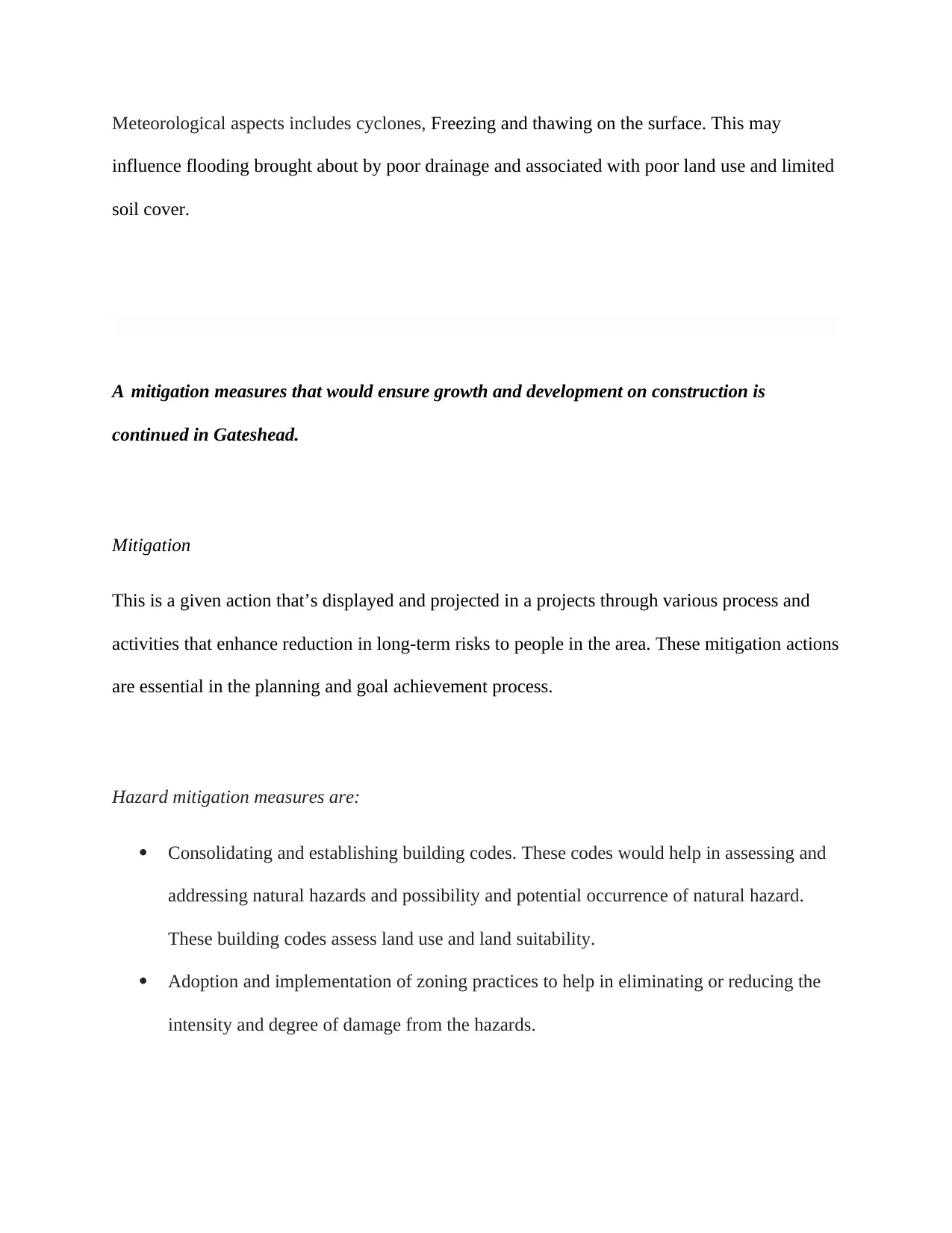
Meteorological aspects includes cyclones, Freezing and thawing on the surface. This may
influence flooding brought about by poor drainage and associated with poor land use and limited
soil cover.
A mitigation measures that would ensure growth and development on construction is
continued in Gateshead.
Mitigation
This is a given action that’s displayed and projected in a projects through various process and
activities that enhance reduction in long-term risks to people in the area. These mitigation actions
are essential in the planning and goal achievement process.
Hazard mitigation measures are:
Consolidating and establishing building codes. These codes would help in assessing and
addressing natural hazards and possibility and potential occurrence of natural hazard.
These building codes assess land use and land suitability.
Adoption and implementation of zoning practices to help in eliminating or reducing the
intensity and degree of damage from the hazards.
influence flooding brought about by poor drainage and associated with poor land use and limited
soil cover.
A mitigation measures that would ensure growth and development on construction is
continued in Gateshead.
Mitigation
This is a given action that’s displayed and projected in a projects through various process and
activities that enhance reduction in long-term risks to people in the area. These mitigation actions
are essential in the planning and goal achievement process.
Hazard mitigation measures are:
Consolidating and establishing building codes. These codes would help in assessing and
addressing natural hazards and possibility and potential occurrence of natural hazard.
These building codes assess land use and land suitability.
Adoption and implementation of zoning practices to help in eliminating or reducing the
intensity and degree of damage from the hazards.
⊘ This is a preview!⊘
Do you want full access?
Subscribe today to unlock all pages.

Trusted by 1+ million students worldwide
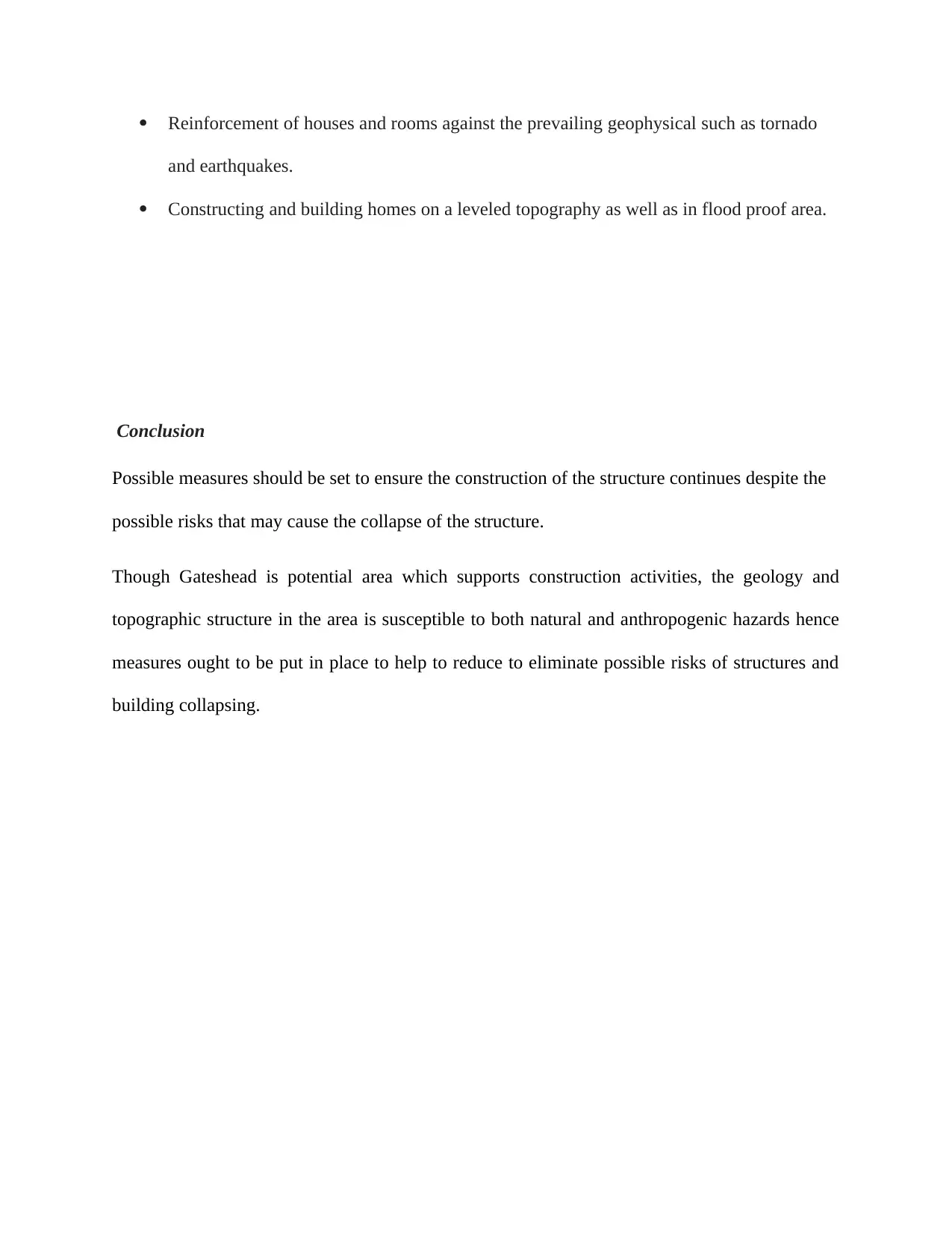
Reinforcement of houses and rooms against the prevailing geophysical such as tornado
and earthquakes.
Constructing and building homes on a leveled topography as well as in flood proof area.
Conclusion
Possible measures should be set to ensure the construction of the structure continues despite the
possible risks that may cause the collapse of the structure.
Though Gateshead is potential area which supports construction activities, the geology and
topographic structure in the area is susceptible to both natural and anthropogenic hazards hence
measures ought to be put in place to help to reduce to eliminate possible risks of structures and
building collapsing.
and earthquakes.
Constructing and building homes on a leveled topography as well as in flood proof area.
Conclusion
Possible measures should be set to ensure the construction of the structure continues despite the
possible risks that may cause the collapse of the structure.
Though Gateshead is potential area which supports construction activities, the geology and
topographic structure in the area is susceptible to both natural and anthropogenic hazards hence
measures ought to be put in place to help to reduce to eliminate possible risks of structures and
building collapsing.
Paraphrase This Document
Need a fresh take? Get an instant paraphrase of this document with our AI Paraphraser
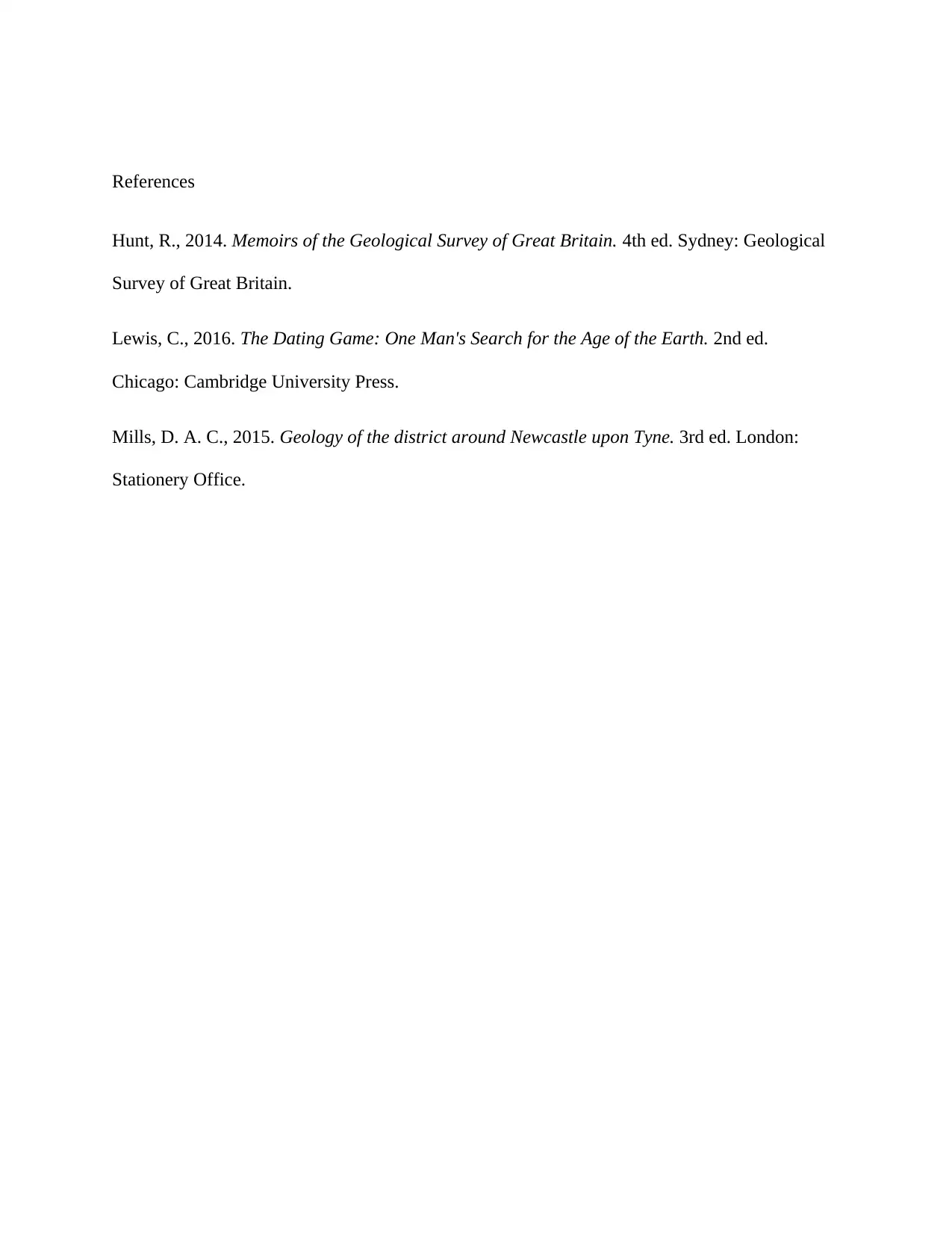
References
Hunt, R., 2014. Memoirs of the Geological Survey of Great Britain. 4th ed. Sydney: Geological
Survey of Great Britain.
Lewis, C., 2016. The Dating Game: One Man's Search for the Age of the Earth. 2nd ed.
Chicago: Cambridge University Press.
Mills, D. A. C., 2015. Geology of the district around Newcastle upon Tyne. 3rd ed. London:
Stationery Office.
Hunt, R., 2014. Memoirs of the Geological Survey of Great Britain. 4th ed. Sydney: Geological
Survey of Great Britain.
Lewis, C., 2016. The Dating Game: One Man's Search for the Age of the Earth. 2nd ed.
Chicago: Cambridge University Press.
Mills, D. A. C., 2015. Geology of the district around Newcastle upon Tyne. 3rd ed. London:
Stationery Office.
1 out of 8
Your All-in-One AI-Powered Toolkit for Academic Success.
+13062052269
info@desklib.com
Available 24*7 on WhatsApp / Email
![[object Object]](/_next/static/media/star-bottom.7253800d.svg)
Unlock your academic potential
Copyright © 2020–2025 A2Z Services. All Rights Reserved. Developed and managed by ZUCOL.
